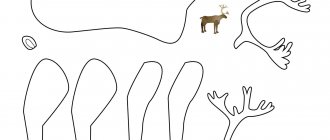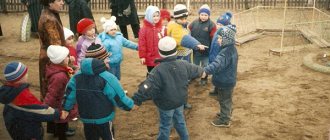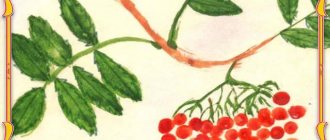Summary of educational activities in the preparatory group of kindergarten using ICT on the topic: Sports
Summary of direct educational activities in the preparatory group on the topic: “Experts in sports”
Author: Elena Valerievna Sozonova, teacher of MBOU Secondary School No. 95, Arkhangelsk. Description of work: I offer you a summary of direct educational activities for children in the preparatory group for school (6-7 years old) on the topic: “Sports Experts.” This material will be useful to teachers of the preparatory group. This summary of an educational lesson is aimed at cultivating interest in winter sports and developing the horizons of older preschool children.
Goal: expanding ideas about the surrounding reality by introducing children to winter sports. Objectives: Educational:
- give children an idea about the features of ice skates;
— to concretize children’s ideas about winter sports; — teach children to recognize and name sports, the necessary inventory, equipment, equipment for a given sport; select appropriate equipment for athletes. Developmental:
- promote the development of involuntary memory, logical thinking, attention, memory;
-develop sports terminology, the ability to use it in speech. Educational:
- formation of attitudes towards a healthy lifestyle;
— promotion of sports activities; Methodological techniques and methods: -verbal (reading and listening, active dialogue, questions, riddles); - visual (displaying a set of pictures depicting winter sports, multimedia presentation “Winter sports experts”); -game (games to develop logical thinking; sedentary games: “Winter fun” and “We are athletes”). Equipment and material: multimedia equipment, ball, pictures depicting sports, equipment (skis, 2 pairs of skates, stick, sled, racket), 2 hoops.
Progress of the lesson.
Introductory part: The teacher invites the children to the music room: Teacher: Good afternoon, dear friends! Today I propose to play an intellectual game called “Sports Experts”. Do you know who the experts are? (Children's answers). Now we will check. You are ready? The teacher draws attention to the sports equipment located on the table: skis, skates, racket, hockey stick, doll sled. Name what you see and how can these objects be called in one word? Children's answers: inventory. Educator: What equipment do you think is superfluous here? Why? Children's answers: Racket. Because we can use all the equipment except the racket in winter. Educator: Let's show how we like to have fun in winter. Physical education teacher: (movements according to the text) What do we like to do in winter? Playing snowballs, skiing, skating on ice, racing down the mountain on a sled. Main part: Educator: We have already talked about the fact that people actively spend time outside in winter. And this pastime has become for some people something more than just walking. Of course, I’m talking now about people who don’t just skate or ski, but compete, showing skill, achieve high results, and strive to win. Educator: What are these people called? Children's answers: Athletes. Educator: Each athlete has his own name. I invite you to play the game “Name the Athlete”. Children are asked to stand in a circle. Throwing the ball to you, I will name the sport, and you return it to me and name the athlete who plays it. - hockey - hockey player; - figure skating - figure skater; - skiing - skier; - speed skating - speed skater; - biathlon-biathlete. Children are asked to sit down and complete tasks. Educator: There are many types of sports, you can’t even count them all. We will now play, name sports. Demonstration of the presentation “Winter Sports Experts”. 1. Riddle-guess “Type of sport” (on the slide) And the athlete shoots at a target, And he races on skis. And the sport is called very simply…..(biathlon) I’ve heard a lot about this sport: Aerial acrobat On skis…(freestyle) There’s a game in the yard in the morning, The kids are playing around. Shouts: “puck!”, “past!”, “hit!” - So there is a game there - .... (hockey) Look: the skier rushes, And then flies like a bird, Having made a jump from the peaks. And the springboard helped him... (ski jumping) How huge it is, Our ice stadium. And the treadmill sparkles like a mirror. I won’t fall on it, I’ll be the first to reach the finish line!... (speed skating) Our artist is dancing on the ice, He’s not wearing a fur coat, he’s lightly dressed. And now the duet is on the ice. Eh, good skating! The audience held its breath. The sport is called... (figure skating) 2. Name the equipment (on the slide) - Helmet, stick, puck, skates. 3.Whose equipment? (on the slide) - Overalls, gloves, goggles, skis with poles and boots (biathlete). 4.Who and what is this? Lost and Found (on slide) -Goalkeeper, protection, gloves - trap, stick, puck (goal). 5.Who needs what? (on the slide) -Figure skater (ice and skates); -Skier (snow, skis); -Hockey player (helmet, stick, puck). The game “Who is doing what” (children are asked to tell, based on pictures depicting sports, what the athletes do). Children's answers: - Biathletes run on skis to the target, shoot at them with a rifle; -Skaters perform a dance on ice on skates; -Skaters run a race, covering a certain distance on an ice stadium in a closed circle; -Hockey players on the court try to score as many pucks as possible into the opponent’s goal by hitting it with their stick. Riddle game “Pretend to be an athlete.” The teacher invites the children to show the athlete’s movements, and for the rest of the children to learn and name the sport. The music “Come on Russia” is playing. 1. "Hockey". The hockey player performs sliding movements with holding the stick and hitting the puck, trying to hit the goal; the goalie hits the puck; 2. "Ski jumping." The child runs and long jumps. 3. "Biathlon" A child skis to the start, stops and pretends to shoot with a rifle; 4. “Figure skating.” Children perform sliding movements, depicting different figures (pair and single skating). Educator: Skiing requires snow and ... (skis), and what is needed for skating sports? (ice and skates). Educator: “Who needs what kind of skates?” For a hockey player - hockey; For a skater - figure skaters; For a speed skater - speed skating. Children are invited to sit down and pay attention to ice skates, demonstrating their different types (figure skates, hockey skates). Teacher's story: “Such different ice skates.” Each sport has its own shoe. Depending on the type of load, different blades are used, sharpening methods, even the appearance of the boot is different. There are 3 main types of skates: hockey, figure skating and speed skating. -Figure skates have a high boot with a heel and laces that rigidly fix the ankle. The tip of the blade has four teeth. These features help to draw figures on the ice. — In hockey skates, the boot is high, quite hard, and has hard inserts in the most open places. The toe of the boot is reinforced (it is made of plastic). This type of boot saves your feet from impact. The blades of the skates are curved, wide, and have no teeth. This allows you not to cling to the ice even during very sharp turns. -(on the slide) Speed skating shoes have low boots with laces. The blades have a lateral curvature. These features help you take turns faster on a small circle. Educator: Let's check if you remember which skates are needed. Game exercise “Dress up an athlete” (on the slide) 2 children invited to the screen on the slide show their choice of solving the issue (children see the effect of a positive result). Final part: Educator: You showed good results, like real athletes in the fight for victory. Now let's summarize our game. “Find and name an extra sport” (on the slide). -Skating, figure skating, hockey, cross-country skiing (cross-country skiing, since this sport requires skis, not skates). -Freestyle, cross-country skiing, ski jumping (ski racing, since sports such as freestyle and ski jumping require a springboard and do not require ski poles). Educator: All winter sports can be divided into two groups. Game "Don't make a mistake." Children are asked to assign pictures to sports based on the given sports equipment. (There are 2 hoops on the floor, one of them contains skates, and the other contains skis). Educator: Why did you make this choice? (children's answers). Educator: Name the types of skiing? Children's answers: cross-country skiing, biathlon, freestyle, ski jumping. Educator: Name skating sports? Children's answers: figure skating, speed skating, hockey. Educator: What does sport give to a person? Children's answers: sport makes a person strong, resilient, and improves health. Educator: What do you need to do to become an athlete? Children's answers: we need to do exercises and exercise. Fizkul We run with you on skis, The cold snow licks the skis. (children pretend to be skiing) And then we were on ice skates (they pretend to be skating) And then we were on a sleigh, (squat down) And then we made snowballs (they make snowballs) And they bombed the fortress. (imitate throws) We played enough, rode (jumping) And we gained health. (show strength) Educator: Well done!
You know winter sports well. I hope that you will be real athletes, experts in your field. The teacher gives the children “Sports Experts” medals. Presentation on the topic: Winter sports connoisseurs
We recommend watching:
Summary of educational activities for cognitive development in the preparatory group “Journey to the North” Summary of educational activities for children of the preparatory group “Types of Transport” Summary of cognitive activities in the preparatory group on the topic “Reservoirs” Summary of educational activities for children of senior preschool age (preparatory group). On the farm
Similar articles:
Summary of a lesson in the preparatory group on the topic: Rules of conduct in kindergarten
Life safety lesson “Rules of safe behavior on water.” Preparatory group
Faculty of Multimedia Technologies of the educational portal "My University"
Summary of an integrated lesson in the preparatory group “Winter Sports”Tasks:
1. Expand children's knowledge about winter sports.
2. Learn to distinguish and correctly name winter sports.
3. Develop logical thinking, attention, memory, and imagination in children.
4. Consolidating the “Scratch” drawing technique
5. To formulate the need of each child for physical activity and physical improvement, the desire to play sports.
Equipment: presentations “Winter Sports” and “Ancient Greece”, film “The First Olympic Games”, cards for completing tasks “Find a Pair”, Whatman paper, candle, watercolor paints, black gouache, toothpicks.
Progress of the lesson:
Children enter the group.
— Guys, look outside the window, what time of year is it now? (winter).
- What time of year is it winter? (frosty, cold)
— In winter, it’s probably very sad, uninteresting?
-What games do you like to play in winter? (snowball fights, sledding, skiing, skating, building a snowman, etc.).
— What do you need for winter games? (sleds, skis, skates, clubs, snow, buckets, shovels).
— What games can’t be played in winter and why? (in the sand, because it is cold and the sand is covered with snow; you cannot play board games, because you can freeze and get sick; in the ball, because the ball is rubber, and rubber is afraid of frost, and the ball will not jump and jump.)
- Look. What is this? (White list). Does it remind you of anything winter? (snow, snow carpet). There are still paints here, let's color this sheet.
Guys, look. What is this? (the Olympic rings appear on the sheet - the emblem of the Olympic Games).
— Children, do you know that the Winter Olympic Games were held in our country? (children's answers).
-Where did they go? (in the city of Sochi). Guys, do you know where this city is? (children's answers). The city of Sochi is located high in the mountains and therefore now roads have been built there, stadiums and ski slopes have been prepared. Many athletes came from all over the world and competed in various winter sports.
- Now please guess the riddle.
(Children’s answers are accompanied by a slide show. Children are given the opportunity to guess what sport is depicted)
There are guys, I have two silver horses.
I drive both at once. What kind of horses do I have? (skates)
-What winter sports use skates? (children's answers).
That's right guys. This is hockey - a very popular sport. More people are playing it. Figure skating is one of the most beautiful winter sports. Speed skating is speed skating. Short track - races in skates on small areas. (View slides depicting these sports).
-Guys, pay attention to the symbolic image of each sport. Maybe someone knows what it's called?
Children's answers.
— Guess the following riddle:
I leave two stripes on the snow as I run.
I fly away from them like an arrow, and they come after me again. (Skis)
What sports involve skiing? (children's answers).
- Absolutely right guys. This is biathlon, where people ski and shoot at targets. Cross-country skiing is the most widespread and popular type of skiing competition, alpine skiing, biathlon, ski jumping, freestyle, Nordic combined. (Looking at the slides. Children try to guess for themselves which sport is depicted. Then the correct answers appear).
Next riddle:
We stood there all summer and waited for winter.
We waited until the time was right and rushed down the mountain. (Sled)
Do you know any sports that use sleds?
There are winter sports such as luge, in which the athlete lies on his back on a sled and guides the sports equipment with body movements. Bobsleigh and skeleton are downhill races on controlled closed and open sleds.
Other winter sports include snowboarding and curling (tell us briefly about these sports). (Looking at the slides).
- Let's play the game "Find the Pair." Select cards (cards are upside down and have winter sports icons on them). Look carefully, on your table there are pictures with the necessary equipment for different sports, only the equipment is all mixed up. You need to determine where, whose inventory is and select the appropriate pictures. (Children choose the necessary equipment, saying out loud: skier - skis, hockey - stick and puck, figure skater - skates, etc.)
- Well done, the guys completed the task. And now you and I will become athletes ourselves. Want to? Then repeat after me.
You and I are running on skis (children pretend to ski) The cold snow licks the skis. And then we were on skates (pretend to be skating) And then we were on a sleigh, (squat down) But suddenly we fell and... Ah! (“fall”) And then they made snowballs (they make snowballs) And they bombed the fortress (they imitate throwing). We played enough, rode (having fun, jumping) And we gained health (show strength).
- Well done boys. Did you know that the first Olympic Games originated in ancient Greece a long time ago and are held every four years? Let's close our eyes. (movie intro plays) What is this music like?
Children's answers.
Open your eyes. (film showing) This is Ancient Greece, the place where the first Olympic Games began...
This is how the first Olympic Games were held. The ancient Greeks believed that a person should engage in sports from childhood to strengthen his body, and music to educate his soul.
Guys, now we can get any information. How do we find out the news? (children's answers) How do you think we learned about these games, since before there were no phones or the Internet?
Children express their guesses.
(Showing images of the first Olympic Games)
-Look. And here is the ancient wall. Let us also try to depict different sports?
(We offer a sheet of whatman paper in the form of a rock, prepared for the grattage technique)
Children use toothpicks to scrape out images of any sport.
Result: Well done, guys? You did great. What did you depict? I think it turned out like the ancient Greeks. You like? Was it interesting for you today? Did you learn anything new? Or maybe something was difficult or unclear for you?
Children talk about their impressions.


